
The Surprise Rescue-Within-a-Rescue in a Flooded Thai Cave
In 2018, before divers could reach a famously stranded junior football team, they first had to save other lives.
Excerpted and adapted with permission from Aquanaut: The Inside Story of the Thai Cave Rescue, by Rick Stanton with Karen Dealy, published January 2022 by Pegasus Books. Copyright © 2022
In June 2018, 12 young members of a junior football team and one of their coaches became stranded by flooding deep in Northern Thailand’s Tham Luang cave system. The international rescue effort that unfolded over the next three weeks had the world holding its breath. Veteran British cave divers Rick Stanton and John Volanthen led the harrowing expedition; they would locate the team and eventually bring every person out safely.
But first, Stanton and Volanthen would have to do an unplanned rescue on their own. Early in the operation, amid rainfall that continued to raise water levels in the subterranean passages, the two divers began preparations to venture deeper into the cave, beyond the presence of an initial staging area at its entrance. They discovered they were not alone.
Inside the cave, we found the entrance chamber had changed drastically from the night before. It was now a large lake, with a river cascading noisily in from the cave’s throat.
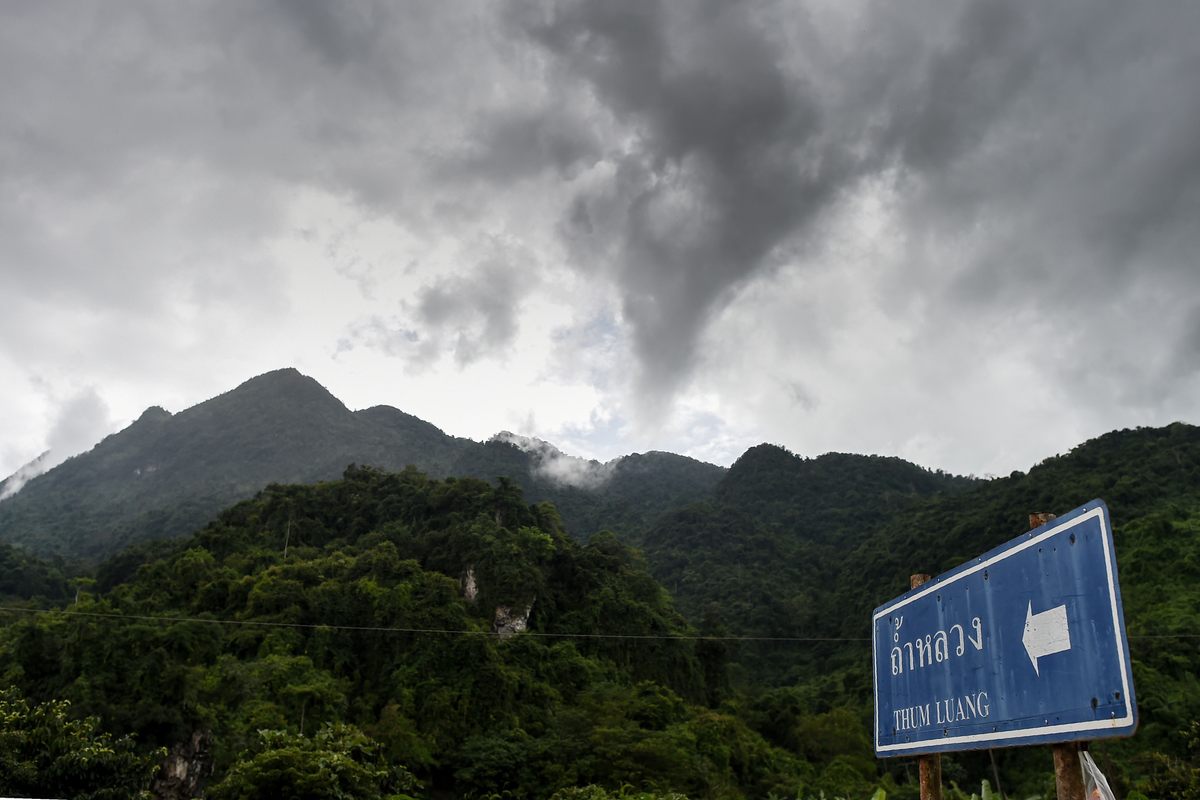
Within 100 meters of the entrance, we encountered a sump we’d been able to walk through just 14 hours earlier. We slipped our fins over our wellies and went in. Immersed in the muddy water, with no visibility and a vicious current, we began the arduous task of laying line as we penetrated further inside. We surfaced at the far end of the sump to find ourselves standing in a river that was surging against us. John and I are both experienced whitewater kayakers, and our knowledge of navigating through swiftly moving water became unexpectedly useful for us as we walked through, placing ourselves strategically to prevent the force of the current from knocking us off our feet or pinning us against the wall at the corners.
The cave back here reeked, polluted with the diesel fuel leaking from the pump beyond Chamber 3. I started to gag and retch. A further short dive led through the archway that had nearly trapped another diver the previous evening, which was now four meters underwater. On its other side, we began ascending through a confusion of cables and large clusters of hose towards the large third chamber. After surfacing, John and I were startled to see a flashlight and hear voices.
‘The boys are here?’ I wondered incredulously. ‘Have some of them found a way out, in desperation?’ As the owners of the voices approached, though, I saw that they were four adult men. My initial disappointment was immediately replaced with confusion, and then aggravation. What on earth were they doing there?
The men were excited to see us, and the one who came forward as their leader was the most excited of them all. Surapin Chaichompoo spoke loudly to us in Thai, and when it became obvious that John and I were foreigners who didn’t understand the language, he began gesticulating wildly with his hands and arms. Somehow, he communicated that the four of them had been working on installing the water pumps there in Chamber 3. When everybody else had made an orderly evacuation 24 hours earlier, they had been napping in an alcove. They’d slept through it all and had awoken to find themselves trapped and abandoned.
‘They must have been here when Rob popped in last night.’ John said exactly what I was thinking. ‘Has nobody even noticed that they’ve been missing?’
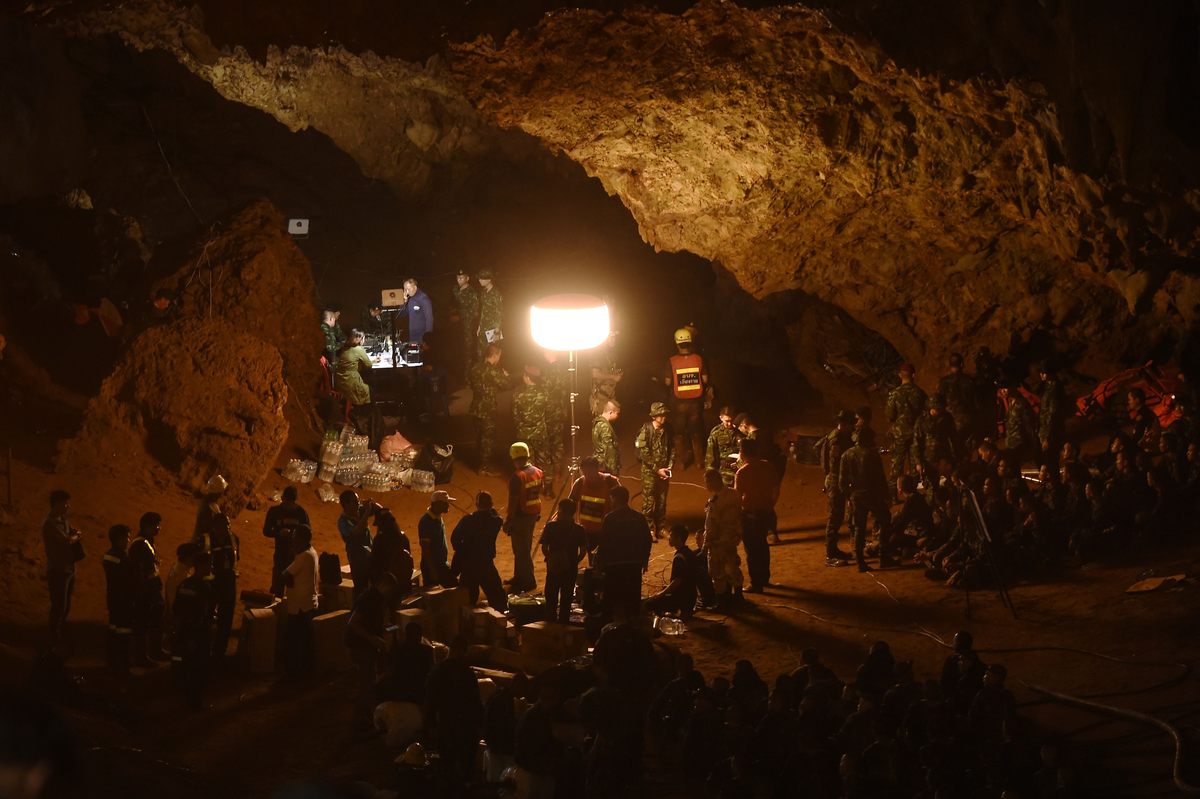
We took off our diving gear and walked around in our wetsuits and wellies to have a look. This side of the chamber was largely comprised of muddy, slippery slopes. Then there was a dividing rib of rock, on the far side of which lay a large sandy plateau, approximately 15 meters in diameter. The trapped men had been placing marks in the sandy rise of the plateau to track the level of the water. At the moment, this plateau was less than a meter above water, and Surapin indicated with excitement that the water had risen half a meter in the past half-hour alone.
We needed to take the men out, but how? There were four of them, two of us, and no spare diving equipment. We didn’t have time to retreat, put together a plan, find reinforcements—who would we have used anyway?—and return in time. Instead, we held a quick discussion.
‘If we leave them here, they’ll be treading water before we get back to them.’
‘Besides, there is nobody else. We’d be the ones to do the rescue anyway.’
‘We have everything we need with us. Let’s just do it.’
Although we had not taken in spare equipment, cave divers depend on redundancy of equipment. Always have at least two of everything you need. Each of our harnesses held two cylinders and each cylinder had its own demand valve attached to it. We used hand gestures to let the men know that we would be diving them out, one at a time, with them breathing off of our spare cylinder. At first, the men seemed more concerned about their phones’ safety than their own rescue. I watched as they carefully wrapped their mobile devices in plastic bags and then put them inside a canvas pouch, which they handed over to me delicately.
None of the men seemed like they’d be particularly comfortable in the water. On the other hand, they were adult men who were desperate to get out and they all seemed willing, so I didn’t think we’d have a problem. I selected one of the younger men to go first. In order to help him acclimatize to being underwater, I first gave him a regulator to practice breathing through while his face was submerged. This typically proves to be helpful in calming a non-diver who would be breathing underwater for the first time, but it didn’t work this time. As soon as his face was immersed, the young man began flailing his arms wildly, pulling his face out of the water and desperately gasping for air. I thought maybe he shouldn’t be the first one out, and that it might comfort him to see others go first. I beckoned to Surapin, who was more agreeable to the learning process, and we soon set off underwater.
What an epic.
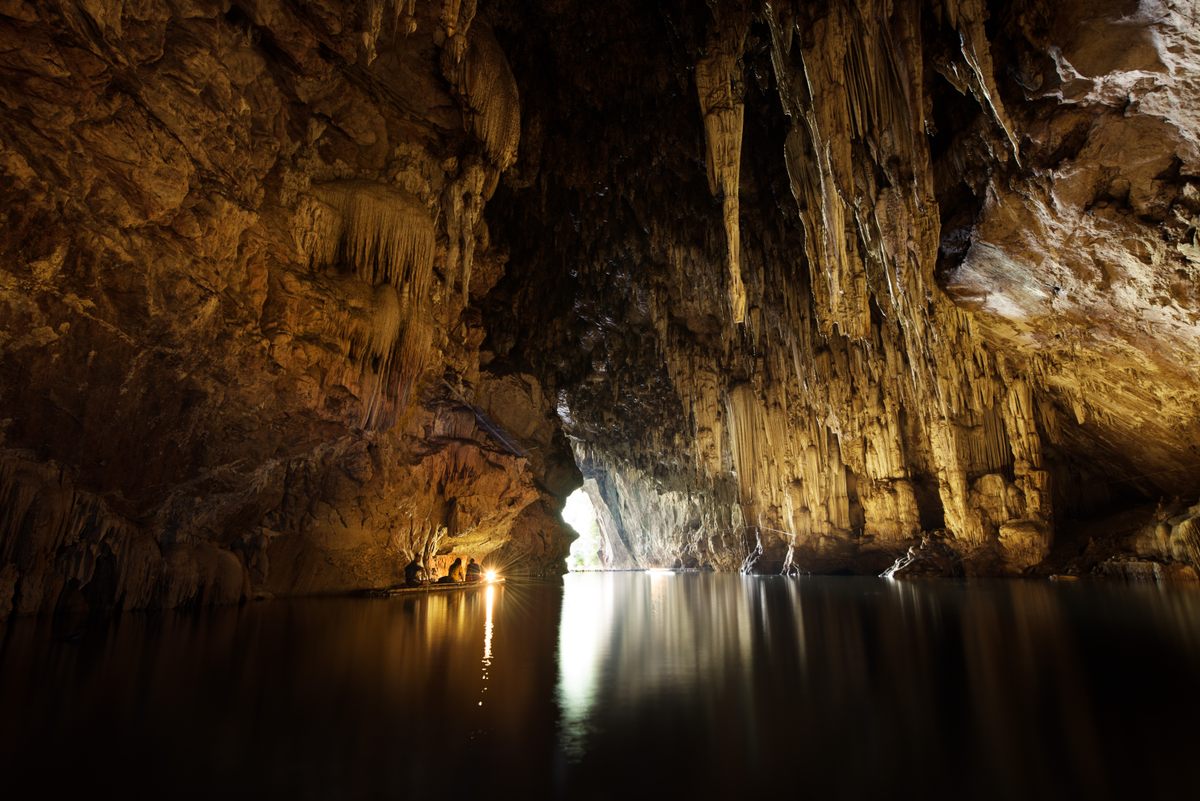
With Surapin breathing through the regulator attached to my second cylinder, he was tethered to me by the hose that was providing his life-sustaining air. He would need to stay by my side. With my arm around his back and my hand gripped onto the armpit of his t-shirt, I kept a secure hold, guiding him through the difficult terrain. My other hand was tightly holding the line to keep us both from getting lost.
Remembering the jumble of hoses and wires I’d encountered on the way in, I knew that diving down to the archway on the way out would be awkward, but I wasn’t expecting to encounter ledges of rock jutting out towards us. The walls and ceiling were jagged with these protruding rocks, which had gone unnoticed on the ceiling above us as we’d passed underneath and ascended. Now, heading down to go out, they kept catching us as we tried to go through. I was doing everything I could to avoid the rocks, but the dive was treacherous. Surapin’s head was exposed—I had no way to protect it, and he didn’t think to use his arms as a shield—and I heard an audible thud each time his head collided with the ceiling. After finally passing through the archway, the sump’s deepest point, Surapin must have sensed that we were rising, and he became desperate. Unaware that we were not beneath an airspace, Surapin tried to swim away from me in an attempt to reach the surface more hastily. I could sense that he had lost control. The rescue turned into an underwater wrestling match.
I struggled to keep a grip on him with one hand while keeping my other hand securely fastened around the line. If he escaped from me, I knew he would have been unlikely to locate the airspace that lay ahead of him, and I would have been hard-pressed to find him. Had I lost the line, we would both be lost. Just as I knew we were close to breaking the surface, the struggles became too much and I released my grip on him, knowing I’d deal with the consequences in a moment after I’d gained my bearings.
The area where he surfaced was low, with maybe 10 centimeters of airspace between the water and the ceiling. I hoped he’d figure to turn onto his back and keep his nose up, but I heard his head strike the roof as he tried to burst out of the water, followed by the sounds of him spluttering for breath and spitting out water. I ascended and surfaced along the line, gained my bearing and made my way back to him, then twisted his head so his nose was sticking into the airspace.
After a few breaths helped to calm him, I led him to an area that was large enough for him to breathe more comfortably. I guided his feet to a sloping ledge where he could stand while he regained his composure. Then, when he was safely on dry land, I clipped the spare reg to its D-ring on my neck strap and dived back to Chamber 3. John was waiting to see how it had gone.
‘That was quite exciting,’ I told him drily. ‘Not in a good way.’
While Surapin and I had been off on our adventure, John had re-evaluated the situation and assessed that the first worker would have been a lot calmer if he’d been wearing a mask. I’d lend my mask to the next worker, and John would come back with it after the dive, then John would lend his to the next man I dived with. John’s mask has prescription lenses and he was hesitant to hand it over—‘If this gets lost, we’re fucked’—but he knew there was no other choice. This situation wasn’t ideal, and we were having to improvise as we went.
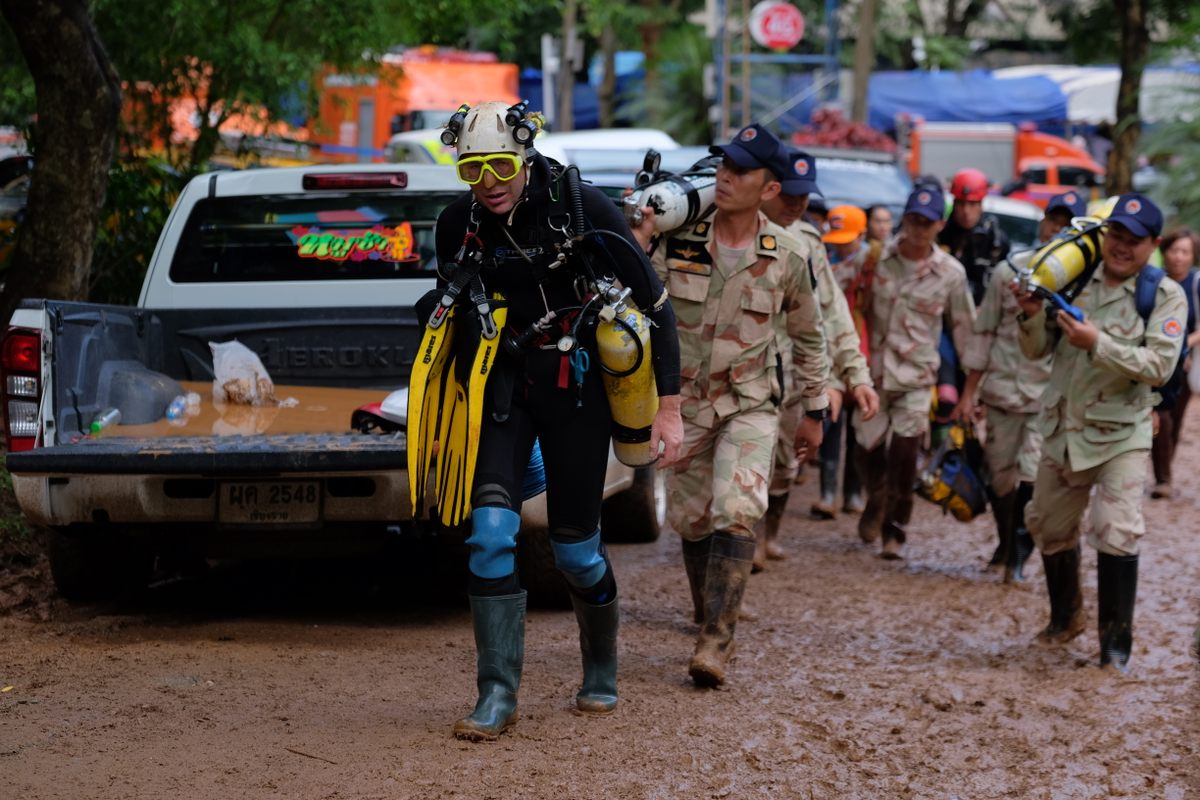
The remaining three dives from Chamber 3 went more smoothly than the first had. By the time John and I made our last exit, the current was considerably stronger and swirling around us in pulses. I wondered if the men had noticed how much the water had risen in the twenty minutes since we’d first arrived.
We found the men were much calmer when they were together again in the second chamber; I was even struck by their resourcefulness when they unplugged one of the electric lights to augment their own weak flashlights. The final dive of the rescue was once again Surapin and me together, leaving for the cave entrance. Despite what had happened earlier, I presumed he still trusted me—he didn’t really have any other choice—but then as poor luck would have it, my light switched off just after we began descending beneath the surface of the water. I briefly debated continuing in darkness, but thought it more prudent to turn around and get the light sorted before completing the dive.
When we surfaced, back where we’d started, Surapin thought that we had reached safety. He tore away from me yet again, running off up the passage in search of the others. I let him go while I fettled with my light, confident he would sort himself out. I knew he didn’t have anywhere to go. Soon he realized this too and came back to me with a quizzical look, not understanding why his friends weren’t there. When my light was fixed, I signaled that we still had to dive out. To his credit, he accepted this relatively calmly.
When we had all successfully reached the entrance chamber, we approached the nearest Thai SEAL as a group. ‘We found these four men in Chamber 3 and brought them out.’ When I heard John say those words out loud, I was struck by how utterly ridiculous the past hour had been. The Thai SEAL looked unimpressed and, understandably, a bit bewildered. Fortunately, we had Surapin—who was never short of words—to explain the situation to them. Before leaving, the four men thanked us repeatedly for saving them, wanting to be sure that we understood their gratitude in spite of the language barrier. I handed over their phones optimistically, and the four men disappeared into the crowd.
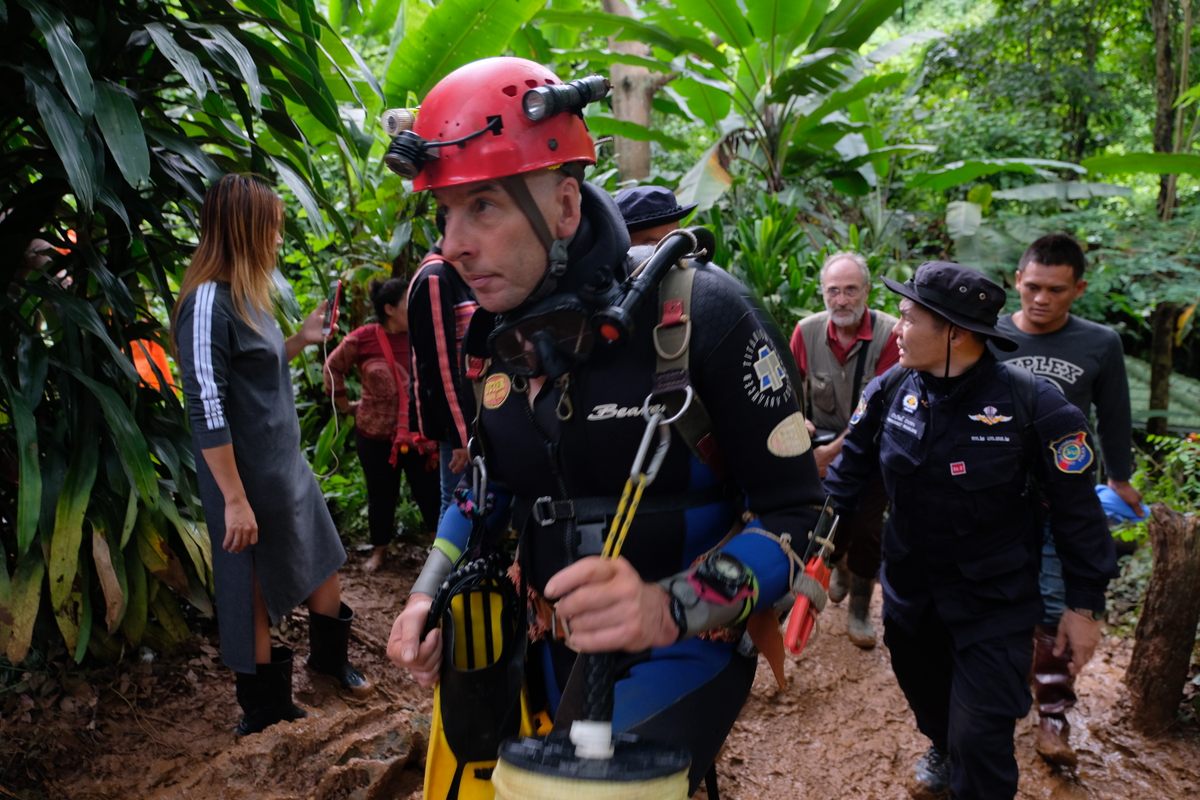
That day’s unexpected rescue mission, full of drama as it had been, provided valuable lessons that would go on to inform many of the decisions we’d make the following week while planning the boys’ rescue. What did we learn? What would we do differently? Our gears were already turning. The boys couldn’t be expected to stay calm during a series of dives that would be much longer and more challenging than the dives these men had just struggled with. We’d have to find a way to account for the panic. Although neither of us held much hope for finding the boys alive, we appreciated that today’s rescue had provided us clear lessons for what would need to be done.
Securely fitting masks … Something to protect their heads during the dive out …
We returned to our gear room in silence, still trying to process everything that had happened and wondering what could possibly go wrong next.














Follow us on Twitter to get the latest on the world's hidden wonders.
Like us on Facebook to get the latest on the world's hidden wonders.
Follow us on Twitter Like us on Facebook